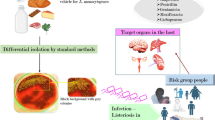Abstract
An analysis was made of the distribution of serovars ofListeria monocytogenes isolated from 1363 patients with listeriosis. Overall, serovar 4b was found in 64 % of cases, serovar 1/2a in 15 %, serovar 1/2b in 10 %, and serovar 1/2c in 4 %. The patients were categorised as pregnancy associated cases, non-pregnant previously healthy cases, and non-pregnant cases with severe underlying illness. The serovars were unequally distributed between these three groups of patients. Serovar 1/2b occurred most often in the non-pregnant cases with severe underlying illness, and serovar 1/2c occurred least frequently in the pregnancy associated cases. Serovar 4b occurred more often in the pregnancy associated cases than in previously healthy non-pregnant cases, and more often in the latter than in those with underlying illness. Similar distributions of the serovars between the categories of patients occurred over different time periods. These results may be interpreted as indicating an association between virulence and serological type ofListeria monocytogenes.
Similar content being viewed by others
References
McLauchlin J:Listeria monocytogenes, recent advances in the taxonomy and epidemiology of listeriosis in humans. Journal of Applied Bacteriology 1987, 63: 1–11.
Seeliger HPR, Hohne K: Serotyping ofListeria monocytogenes and related species. In: Bergan T, Norris JR (ed): Methods in microbiology, Volume 13. Academic Press, London, 1979, p. 31–49.
McLauchlin J, Audurier A, Taylor AG: Aspects of the epidemiology of humanListeria monocytogenes infections in Britain 1967–1984; the use of serotyping and phage typing. Journal of Medical Microbiology 1986, 22: 367–377.
Kampelmacher EH, van Noorle Jansen LM: Listeriosis in humans and animals in the Netherlands (1958–1977). Zentralblatt für Bakteriologie, medizinische Mikrobiologie, Infektionskrankheiten und Parasitologie (A) 1980, 246: 211–227.
Schmidt-Wolf G, Seeliger HPR, Schrettenbrunner A: Menschliche Listeriose-Erkrankungen in der Bundesrepublik Deutschland, 1969–1985. Zentralblatt für Bakteriologie, Mikrobiologie und Hygiene (A) 1987, 265: 472–486.
Albritton WL, Cochi SL, Feeley JC: Overview of neonatal listeriosis. Clinical and Investigative Medicine 1984, 7: 311–314.
Smith H: The development of studies on the determinants of bacterial pathogenicity. Journal of Comparative Pathology 1988, 98: 253–273.
Pini PN, Gilbert RJ: The occurrence in the UK ofListeria species in raw chickens and soft cheeses. International Journal of Food Microbiology 1988, 6: 317–326.
Knorz W, Hof H: Zur Pathogenität von Listerien. Immunität und Infektion 1986, 14: 76–80.
Hof H: Virulence of different strains ofListeria monocytogenes serovar 1/2. Medical Microbiology and Immunology 1984, 173: 207–218.
Piffaretti JC, Kressebuch H, Aeschbacher M, Bille J, Bannerman E, Musser JM, Selander RK, Rocourt J: Genetic characterization of clones of the bacteriumListeria monocytogenes causing epidemic disease. Proceedings of the National Academy of Sciences of the USA 1989, 86: 3818–3822.
Hof H, Hefner P: Pathogenicity ofListeria monocytogenes in comparison to otherListeria species. Infection 1988, 16, Supplement: 141–144.
Wirsing von Koenig CH, Heymer B, Hof H, Finger H: Course of infection and development of immunity in experimental infection of mice withListeria serotypes. Infection and Immunity 1983, 40: 1170–1177.
Mainou-Fowler T, MacGowan AP, Postlethwaite R: Virulence ofListeria species: course of infection in resistant and susceptible mice. Journal of Medical Microbiology 1988, 27: 131–140.
Gaillard JL, Berche P, Sansonetti P: Transposon mutagenesis as a tool to study the role of hemolysin in the virulence ofListeria monocytogenes. Infection and Immunity 1986, 52: 50–55.
Kathariou S, Metz P, Hof H, Goebel W: Tn916-induced mutations in the hemolysin determinant affecting virulence ofListeria monocytogenes. Journal of Bacteriology 1987, 169: 1291–1297.
Hof H, Chatzipanagiotou S: The role of surface structures ofListeria species for pathogenicity. Annales de l'Institut Pasteur: Microbiology 1987, 138: 268–273.
Kuhn M, Goebel W: Identification of an extracellular protein ofListeria monocytogenes possibly involved in intracellular uptake by mammalian cells. Infection and Immunity 1989, 57: 55–61.
Galsworthy SB: Role of the cell surface in virulence ofListeria monocytogenes. Annales de l'Institut Pasteur: Microbiology 1987, 138: 273–276.
Welch DF, Sword CP, Brehm S, Dusanic D: Relationship between superoxide dismutase and pathogenic mechanisms ofListeria monocytogenes. Infection and Immunity 1979, 23: 863–872.
Fielder F, Ruhland GJ: Structure ofListeria monocytogenes cell walls. Bulletin de l'Institut Pasteur 1987, 85: 287–300.
Author information
Authors and Affiliations
Rights and permissions
About this article
Cite this article
McLauchlin, J. Distribution of serovars ofListeria monocytogenes isolated from different categories of patients with listeriosis. Eur. J. Clin. Microbiol. Infect. Dis. 9, 210–213 (1990). https://doi.org/10.1007/BF01963840
Issue Date:
DOI: https://doi.org/10.1007/BF01963840




